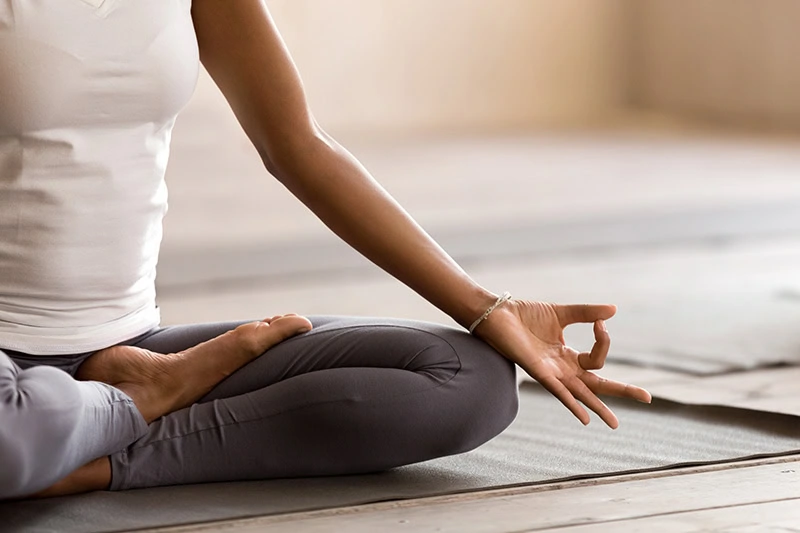The journey to sobriety is often described as a path of self-discovery, healing, and finding balance. For many, this path includes powerful tools that support mental and emotional well-being. One of the most effective tools is meditation. By fostering mindfulness and inner peace, meditation can become a cornerstone of a strong and lasting recovery.
But a common question arises for those new to the practice: How often should you meditate, and what if you’re in recovery? It depends on your individual needs, your stage of recovery, and your personal comfort level. At SEE Purpose Center for Addiction Treatment in Bloomfield, IN, we integrate holistic therapies like meditation into our programs. We encourage clients in detox, inpatient, and aftercare to explore mindfulness as a way to build resilience and find inner calm. This guide will help you understand how to create a meditation practice that works for you.
Understanding Meditation in Recovery
Meditation is not about emptying your mind of all thoughts. Instead, it’s the practice of achieving mindfulness, which is observing your thoughts, feelings, and other internal experiences without judgment.1 It teaches you to sit with your feelings, acknowledge them, and let them pass. For someone in recovery, this skill is invaluable. It helps manage cravings, reduce stress, and cultivate a sense of inner stability.2
Types of Meditation
There are many forms of meditation, and finding one that resonates with you can make the practice more enjoyable and sustainable. Some common types include:
- Mindfulness Meditation: This involves focusing on your breath and observing your thoughts, feelings, and bodily sensations as they arise. It’s about being present in the moment.
- Guided Meditation: Led by a teacher or an audio recording, this type of meditation walks you through visualizations or relaxation techniques. It can be a great starting point for beginners.
- Loving-Kindness Meditation: This practice involves directing feelings of love and compassion towards yourself and others. It can help heal feelings of shame or guilt often associated with addiction and also reduce stress.3
- Walking Meditation: If sitting still is a challenge, walking meditation allows you to practice mindfulness while in motion, focusing on the physical sensation of each step.
How Often Should You Meditate? Balancing Consistency and Needs
The key to a successful meditation practice is consistency, not duration. It’s more effective to meditate for five minutes every day than for an hour once a week. The goal is to build a habit that becomes a natural part of your daily life. Research shows that measurable changes can be seen in just 8 weeks of meditation, but this has to be consistent.4
Start small. Begin with just a few minutes each day and gradually increase the time as you feel more comfortable. Many people find it helpful to meditate first thing in the morning to set a positive tone for the day, while others prefer to meditate in the evening to unwind. Ideally, research it’s more effective to push your meditation sessions to 20 minutes a day as opposed to 10 minutes a day.5
Establishing a routine is crucial. By meditating at the same time each day, you signal to your brain that it’s time to slow down and focus. This consistency helps build the neural pathways that support mindfulness, making the practice easier and more effective over time. As your practice deepens, you might find yourself wanting to meditate for longer periods or more frequently, especially during stressful times. Listen to your body and mind, and adjust your routine as needed.
Creating a Meditation Space
Your environment plays a significant role in your ability to relax and focus. While you can meditate anywhere, creating a dedicated space can make the practice more inviting.
Find a quiet corner in your home where you won’t be disturbed. This space doesn’t need to be elaborate. A comfortable cushion or chair, a soft blanket, and perhaps a candle or some calming essential oils can be enough to create a peaceful atmosphere.
The most important element is your intention. When you enter your meditation space, leave your phone and other distractions behind. Allow this to be a sanctuary where you can connect with yourself without judgment. This intentional act of creating a mindful environment reinforces your commitment to your recovery and well-being.
The Transformative Power of Meditation
Meditation is more than just a relaxation technique; it’s a practice that can fundamentally change your relationship with yourself and the world around you. For those in addiction recovery, it offers a pathway to inner peace, resilience, and a deeper sense of purpose. By learning to observe your thoughts and feelings without being controlled by them, you reclaim your power and build a foundation for a life free from substance abuse.
If you’re ready to explore the benefits of meditation and holistic therapy, SEE Purpose is here to help. Our dedicated team can help you understand how to integrate mindfulness into your recovery journey, providing the tools and support you need to thrive. Contact us today to learn more about our addiction recovery in Bloomfield, IN, and start your path toward healing.
Frequently Asked Questions
What if I can’t sit still during meditation?
This is a very common concern, especially for beginners. If you find it difficult to sit still, start with shorter sessions of just 1-2 minutes. You can also try a walking meditation, where you focus on the sensation of your feet on the ground. Another option is a body scan meditation, where you bring awareness to different parts of your body while lying down. Remember, the goal is not perfect stillness, but gentle awareness.
How do I know if I’m meditating correctly?
There’s no single “correct” way to meditate. The practice is about intention and awareness. If you are sitting with the intention to be present and you are gently bringing your focus back to your breath whenever your mind wanders, you are doing it right. Don’t get discouraged by a busy mind—that’s normal. The practice is the gentle act of returning to your anchor (your breath) again and again.
Can meditation replace therapy or other recovery programs?
Meditation is a powerful supplement to a comprehensive recovery plan, but it should not be seen as a replacement for professional therapy, support groups, or medical treatment. It is one of many tools that can support your journey. At SEE Purpose, we integrate mindfulness practices alongside evidence-based therapies like CBT and EMDR to treat the whole person.
What is the best time of day to meditate?
The best time to meditate is the time you can consistently commit to. Many people find success meditating in the morning to start their day with a clear mind. Others prefer the evening to decompress from the day’s stress. Experiment with different times to see what fits best into your schedule and helps you feel the most benefit.
Are there apps or resources you recommend for beginners?
Yes, there are many excellent resources available. Guided meditation apps like Headspace, Calm, and Insight Timer are popular choices for beginners. They offer a wide range of guided sessions for different needs, such as stress relief, focus, and sleep. Many free resources are also available on platforms like YouTube.
How long does it take to see the benefits of meditation in recovery?
While some people feel a sense of calm after their very first session, the more profound benefits of meditation develop over time with consistent practice. You might notice small changes within a few weeks, such as feeling less reactive to stress or sleeping better. Over months, you can develop deeper self-awareness and emotional regulation. Be patient and compassionate with yourself as you build this new habit.
Can meditation help with co-occurring disorders like anxiety or depression?
Absolutely. Meditation, particularly mindfulness meditation, has been shown to be effective in reducing symptoms of anxiety and depression. It teaches you to observe anxious or depressive thoughts without getting entangled in them, which can lessen their power. It’s a key component of holistic treatment for co-occurring disorders, which we specialize in at SEE Purpose.
References
- American Psychological Association. (2022). Mindfulness. American Psychological Association. https://www.apa.org/topics/mindfulness
- Tapper, K. (2018). Mindfulness and craving: effects and mechanisms. Clinical Psychology Review, 59, 101–117. https://doi.org/10.1016/j.cpr.2017.11.003
- Hofmann, S. G., Grossman, P., & Hinton, D. E. (2011). Loving-kindness and compassion meditation: Potential for psychological interventions. Clinical Psychology Review, 31(7), 1126–1132. https://doi.org/10.1016/j.cpr.2011.07.003
- McGreevey, S. (2011, January 21). Eight weeks to a better brain. Harvard Gazette; Harvard Gazette. https://news.harvard.edu/gazette/story/2011/01/eight-weeks-to-a-better-brain/
- Palmer, R., Roos, C., Vafaie, N., & Kober, H. (2023). The effect of ten versus twenty minutes of mindfulness meditation on state mindfulness and affect. Scientific Reports, 13(1), 20646. https://doi.org/10.1038/s41598-023-46578-y




